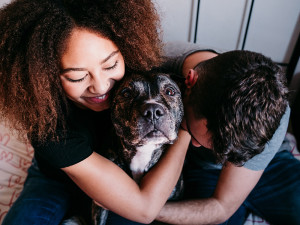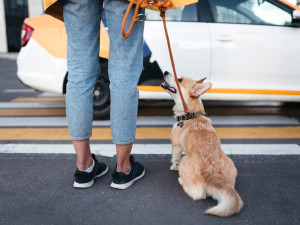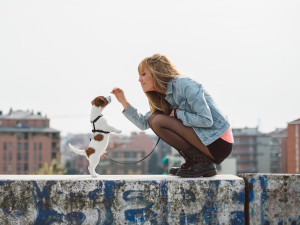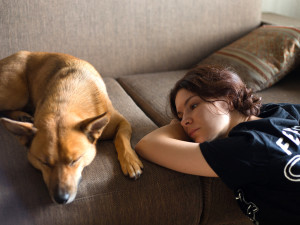How to Get Your Dog to Pay Attention to You
Here are some simple steps to pry your pup away from that one spot in the yard they’re obsessed with.
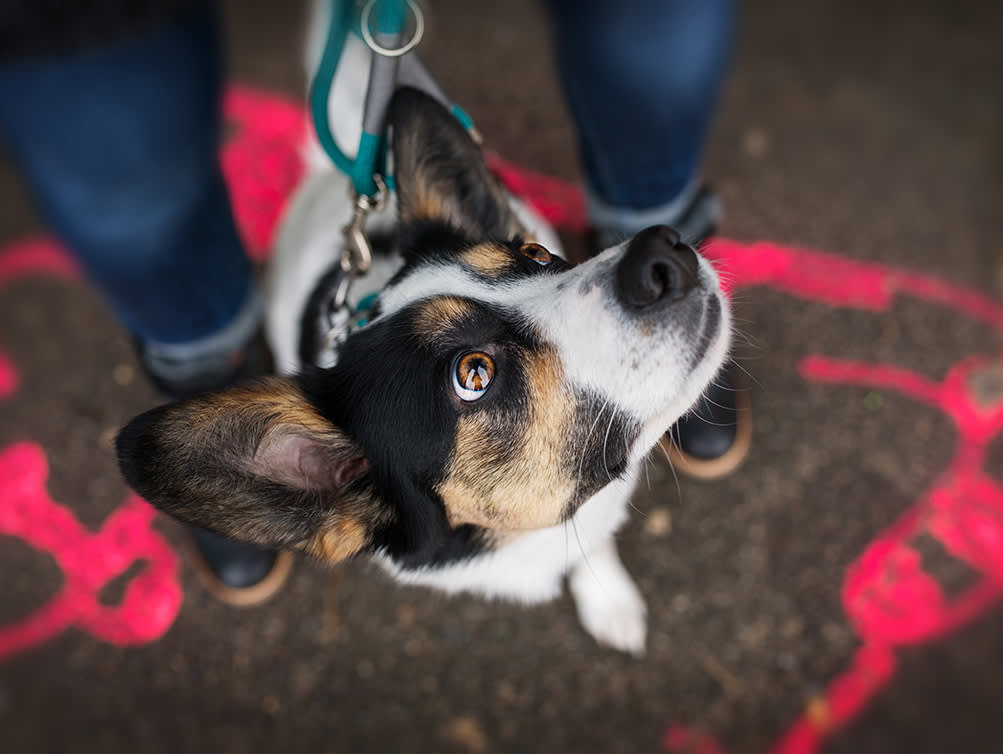
Share Article
In my time as a trainer, I’ve seen dogs who give their pet-parent constant attention, dogs who couldn’t seem to care less, and dogs who learned over time to focus in on their guardian on cue. A pup’s focus is unpredictable: Some naturally attentive dogs are clingy and some are social butterflies who are just drawn to people. Still others are a bit possessive, treating their guardians as though they are the best bones in the world and need constant attention to maintain their safety. While these traits can be modified, they cannot be created out of thin air or fundamentally changed. Dogs either have this behavioral tendency or they don’t.
Few dogs are as naturally attentive as most of us wish; if yours isn’t, don’t feel bad or wonder what you did wrong. Your dog, like most dogs, just isn’t built that way. For some guardians, that’s a good thing. Plenty of people prefer pups with their own interests who can amuse themselves and aren’t staring at them expectantly, waiting to be entertained. But it’s important to be able to get your dog’s attention, too. Luckily, even inattentive pups can learn to respond to cues.
Building Stronger Relationships
The strength of your relationship has an impact on your dog’s attentiveness. If you have consistently been a source of what makes your dog happy, attention is a likely side effect. If you have a love between the two of you and a strong history of fun together, your dog might be more likely to feel motivated to pay attention to you in any given moment.
While a good relationship can help with attention issues, it won’t necessarily guarantee a high level of attentiveness. It won’t. It’s just one piece of the puzzle, and if your dog is not highly attentive in all situations, it certainly doesn’t mean that the relationship is flawed or in any way lacking. It just means that, for whatever reason, your dog is focusing on other aspects of the environment.

Many people find that their dogs are so engrossed in what’s around them and all its wonderful smells that getting them to pay attention outdoors feels like swimming upstream. Though such “nose to the ground” dogs are indeed among the most challenging when it comes to working on attentiveness, many of them are actually paying attention to their people without obvious signs of doing so. It’s common for those with dogs who are particularly responsive to the environment to note that their dogs always know where they are when they’re out and about. But the dogs’ top priority in that context isn’t interacting with people; it’s interacting with the environment. They tend to show their affiliation in other ways at other times, and that’s where the strength of the relationship is more obvious to the casual observer.
Many factors affect your relationship, including your respective personalities and your interactions over time. If your dog associates you with treats, enjoyable training, massages, outings, toys, and games, you’re more likely to have their attention. In the best of relationships, there’s also an intangible quality: some individuals hit it off in an indefinable, magical way. Strong bonds of love are often made of those special and inexplicable connections. If a relationship is damaged or not very strong, the dog may give more attention to someone else.
Putting Attention On Cue
“My dog pays me no mind when they’re outside off leash.” “My dog is always blowing me off.” “They know they’re supposed to listen to me, but they ignore me if anything else is going on.” These are all common complaints from people struggling with getting their dogs to pay attention on cue.
The problem many of us have with a dog who is not responsive to cues, especially outside, is not so much a matter of devotion but of training. For most dogs, learning a “pay attention” cue in the face of a whole world of wonder is essentially a difficult, high-level trick and must be taught as such. Yes, some dogs learn this quickly and thoroughly without too much trouble, but that’s unusual. For most dogs, expect top-quality responses only after consistent, long-term training efforts.
In the larger scheme of things, a cue to pay attention is essential because it is the basis of all training. You can teach a dog just about anything if you have their attention, but it’s virtually impossible if you don’t. Asking for a dog’s attention is a top priority for professional trainers, which is why it is often the first skill taught in classes or private lessons.
This is especially valuable for dogs who don’t frequently offer their attention spontaneously. Teaching dogs to give attention when they don’t consistently offer it on their own requires more time and effort because you have to teach the behavior and associate it with a cue.
Effective Attention Training Behaviors
The two most common cues for attention are “watch” and the dog’s name. “Watch” tells a dog to look at your face, and it’s a great way to keep a dog from paying attention to things that cause them to act in an undesirable way. Saying the dog’s name lets them know that they should pay attention to you and wait for more information.
Once you have your dog’s attention, it’s easier for them to respond to other cues, including “down,” “stay” and “come,” or simply to follow you in a new direction on a walk. It’s important to reinforce these behaviors so your dog’s glad they did what you asked. If they learn that they’ll receive a treat or have a chance to play for giving you their attention in response to the cue “watch” or to their name, they will be more likely to give you their attention when asked in the future.
Paying attention will be easier for your dog in some contexts than in others. Typically, dogs are more likely to pay attention inside than outside, and when there are no distractions — no squirrels or smells of food or other interesting things in the air. Like any other skill, giving attention on cue requires practice and takes time to teach. Gradually working toward giving attention in increasingly challenging environments is a good strategy. Improving the relationship so that the dog is more inclined to pay attention will also improve your dog’s responsiveness to you.
More Trainer Tricks
Ideally, dogs keep track of where their human is. It’s a sign of maturity to be able to sniff in the grass, romp with a canine buddy, and still occasionally check in. Although dogs with certain natural tendencies are more likely to do this, others can be trained to act the same way.
When I’m teaching dogs to exhibit this behavior, I do it in places that allow them to be safely off leash, where they can wander and sniff to their hearts’ content. When the dog is in their own world and not attending to me at all, I position myself so that I can see the dog, but they can’t see me. When they look up and seem just a little concerned, I call them to come, reinforcing them for their successful search. (If the dog becomes stressed, I come out of my hiding spot so they can see me and still reinforce them for coming to me.)
This is a good way to perfect recalls and teach your dog that it’s wise to keep track of you, but it only works with dogs who are connected enough to care when they think for a moment that their human is lost. It is not helpful with aloof dogs or those who are completely unperturbed by your absence, and it’s just cruel to disappear on a clingy, nervous dog. Reserve this technique for those who are stable enough to handle your absence and connected enough to care — which, fortunately, is the majority of dogs.
Remember, when we talk about our dogs paying attention to us, we are really talking about two things: spontaneous attention and attention given on cue. There are many ways to improve both kinds of attentiveness, but that doesn’t mean you can change a dog’s essential nature. All the training in the world isn’t going to turn an aloof and independent dog or a dog who is wildly distracted by the smells of the great outdoors into one who is compulsive about checking in. But it is possible to teach any dog to respond properly to the cue “watch” and to their name and to come when called.
It’s also possible, and desirable, to strengthen your relationship with your dog to increase their attentiveness to you. The more fun and satisfying your interactions are, the more likely your dog is to give you their attention spontaneously or on cue.

Karen B. London, PhD, CAAB, CPDT-KA
Karen B. London is a certified applied animal behaviorist (CAAB) and certified professional dog trainer (CPDT) who specializes in working with dogs with serious behavioral issues, including aggression. She has written for a variety of magazines including The Bark, Clean Run, and the APDT Chronicle of the Dog, and has published in scientific journals including Behavioral Ecology and Sociobiology, Ethology, Ecology, and Evolution, the Journal of Insect Behavior, and Insectes Sociaux. She is the author of seven books about dog training and canine behavior, including the forthcoming My Dog's Mystery Adventure: And Other Stories From a Canine Behaviorist and Dog Trainer.
Related articles
Does My Dog Love Me? How to Interpret Canine Bonding Behavior
What to do when you don’t feel the close bond you want.
![Old Great Dane dog sitting in grass and looking up at the hand of his owner during a training sessions]()
Are You Making These Common Dog Training Mistakes?
Pro Karen London, PhD shares the most common dog training errors and how to correct them.
![Couple hugs their merle Boxer]()
How to Improve Your Relationship with Your Dog
Animal behaviorist Dr. Karen B. London on how to strengthen your pet-parent bond.
![Man hugging his fluffy white dog happily]()
Chemistry Between People and Dogs Is Real (It’s Science)
How the “love hormone” oxytocin connects us with our pups.
![A woman in a black coat squatting down to speak to her Dalmatian dog who is looking away from her to the camera on a dirt path next to a pond on with fall leaves around]()
Hey, Why Is Your Dog Ignoring You?
Six tips and tricks to get your dog to listen to you.
![Dog Completing Tricks During Training In Park]()
How to Make a Comeback After a Dog-Training Fail
Almost all new puppy parents fall at the first hurdle. Here, pro tips on picking yourself up.
